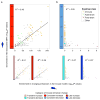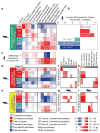Conserved epigenomic signals in mice and humans reveal immune basis of Alzheimer's disease
- PMID: 25693568
- PMCID: PMC4530583
- DOI: 10.1038/nature14252
Conserved epigenomic signals in mice and humans reveal immune basis of Alzheimer's disease
Abstract
Alzheimer's disease (AD) is a severe age-related neurodegenerative disorder characterized by accumulation of amyloid-β plaques and neurofibrillary tangles, synaptic and neuronal loss, and cognitive decline. Several genes have been implicated in AD, but chromatin state alterations during neurodegeneration remain uncharacterized. Here we profile transcriptional and chromatin state dynamics across early and late pathology in the hippocampus of an inducible mouse model of AD-like neurodegeneration. We find a coordinated downregulation of synaptic plasticity genes and regulatory regions, and upregulation of immune response genes and regulatory regions, which are targeted by factors that belong to the ETS family of transcriptional regulators, including PU.1. Human regions orthologous to increasing-level enhancers show immune-cell-specific enhancer signatures as well as immune cell expression quantitative trait loci, while decreasing-level enhancer orthologues show fetal-brain-specific enhancer activity. Notably, AD-associated genetic variants are specifically enriched in increasing-level enhancer orthologues, implicating immune processes in AD predisposition. Indeed, increasing enhancers overlap known AD loci lacking protein-altering variants, and implicate additional loci that do not reach genome-wide significance. Our results reveal new insights into the mechanisms of neurodegeneration and establish the mouse as a useful model for functional studies of AD regulatory regions.
Conflict of interest statement
The authors declare no competing financial interests.
Figures












Similar articles
-
Enhancer variants associated with Alzheimer's disease affect gene expression via chromatin looping.BMC Med Genomics. 2019 Sep 9;12(1):128. doi: 10.1186/s12920-019-0574-8. BMC Med Genomics. 2019. PMID: 31500627 Free PMC article.
-
Molecular and functional signatures in a novel Alzheimer's disease mouse model assessed by quantitative proteomics.Mol Neurodegener. 2018 Jan 16;13(1):2. doi: 10.1186/s13024-017-0234-4. Mol Neurodegener. 2018. PMID: 29338754 Free PMC article.
-
Epigenetic mechanisms underlying enhancer modulation of neuronal identity, neuronal activity and neurodegeneration.Neurobiol Dis. 2021 Jan;147:105155. doi: 10.1016/j.nbd.2020.105155. Epub 2020 Oct 27. Neurobiol Dis. 2021. PMID: 33127472 Review.
-
Genetic risk for Alzheimer's disease is concentrated in specific macrophage and microglial transcriptional networks.Genome Med. 2018 Feb 26;10(1):14. doi: 10.1186/s13073-018-0523-8. Genome Med. 2018. PMID: 29482603 Free PMC article.
-
The epigenome in Alzheimer's disease: current state and approaches for a new path to gene discovery and understanding disease mechanism.Acta Neuropathol. 2016 Oct;132(4):503-14. doi: 10.1007/s00401-016-1612-7. Epub 2016 Aug 29. Acta Neuropathol. 2016. PMID: 27573688 Free PMC article. Review.
Cited by
-
The dual roles of cytokines in Alzheimer's disease: update on interleukins, TNF-α, TGF-β and IFN-γ.Transl Neurodegener. 2016 Apr 5;5:7. doi: 10.1186/s40035-016-0054-4. eCollection 2016. Transl Neurodegener. 2016. PMID: 27054030 Free PMC article. Review.
-
Early-life DNA methylation profiles are indicative of age-related transcriptome changes.Epigenetics Chromatin. 2019 Oct 8;12(1):58. doi: 10.1186/s13072-019-0306-5. Epigenetics Chromatin. 2019. PMID: 31594536 Free PMC article.
-
DNA methylation dynamics during embryonic development and postnatal maturation of the mouse auditory sensory epithelium.Sci Rep. 2018 Nov 26;8(1):17348. doi: 10.1038/s41598-018-35587-x. Sci Rep. 2018. PMID: 30478432 Free PMC article.
-
Turning omics data into therapeutic insights.Curr Opin Pharmacol. 2018 Oct;42:95-101. doi: 10.1016/j.coph.2018.08.006. Epub 2018 Aug 24. Curr Opin Pharmacol. 2018. PMID: 30149217 Free PMC article. Review.
-
The accessible chromatin landscape of the murine hippocampus at single-cell resolution.Genome Res. 2019 May;29(5):857-869. doi: 10.1101/gr.243725.118. Epub 2019 Apr 1. Genome Res. 2019. PMID: 30936163 Free PMC article.
References
-
- Alzheimer’s_Association. 2014 Alzheimer’s disease facts figures. Alzheimers Dement. 2014;10 (2):e47–92. - PubMed
-
- Cruz JC, Tseng HC, Goldman JA, Shih H, Tsai LH. Aberrant Cdk5 activation by p25 triggers pathological events leading to neurodegeneration and neurofibrillary tangles. Neuron. 2003;40 (3):471–483. - PubMed
Publication types
MeSH terms
Substances
Associated data
- Actions
Grants and funding
LinkOut - more resources
Full Text Sources
Other Literature Sources
Medical
Molecular Biology Databases

